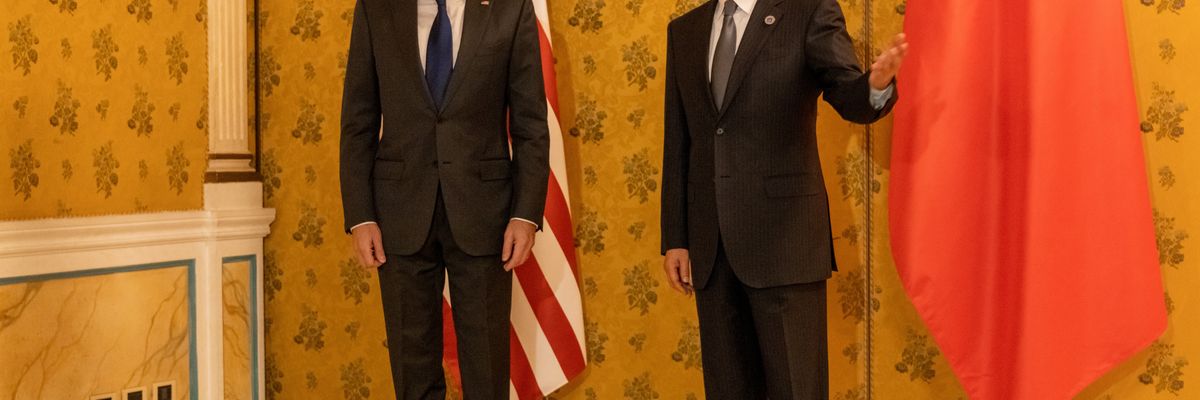Washington has developed a general skepticism over the efficacy of official U.S.-China dialogue. In recent years, the United States has largely abandoned diplomacy and engagement in favor of militant posturing. But these changes reflect political expediency, not the failure of diplomacy. In fact, quantitative and qualitative assessments of U.S.-China dialogues reveal the processes were critical in stabilizing the relationship.
New research conducted by the National Committee on American Foreign Policy, the American Friends Service Committee, and four independent researchers on the diplomatic commitments made during the Obama administration shows diplomatic efforts with China were paying significant dividends for U.S. interests.
The researchers examined the nearly 1,000 commitments the two countries made to each other between 2010 and 2016 and tracked their outcomes. The extensive audit revealed that official dialogue processes (then known as the Strategic & Economic Dialogue) contributed significantly to U.S. and global security by stabilizing the global economy in the wake of the 2008 financial crisis, addressing climate change, and improving public health and pandemic response. It also enhanced security cooperation, helped clamp down on illegal wildlife trafficking, and improved nuclear waste disposal efforts.
This research not only demonstrates what U.S. diplomacy can achieve with China but also reveals how these low-cost engagements are necessary for managing peaceful relations between the two countries.
Today, U.S.-China tensions are undermining international cooperation to stem the spread of COVID-19 and are damaging the international system. Before the zero-sum competition narrative dominated Washington policy circles, the United States and China cooperated closely to address the Ebola crisis in Africa, even agreeing to jointly set up the Africa Center for Disease Control and Prevention. The Africa CDC was established just before the 2020 COVID-19 outbreak, after the United States withdrew from the project citing concerns about China’s data collection interests.
Stabilizing the global economy — a potentially urgent need as the COVID-19 crisis drags on — was another area of diplomatic progress in the Obama era. After the 2008 global financial crisis, the United States and China agreed to a series of measures to spur economic recovery and growth. In these discussions, China committed to raising its share of domestic consumption and the United States to raising domestic savings rates; these policy changes required clear and continuous communication from both parties to ensure smooth implementation. Critically, both countries also committed to reforms for over-the-counter derivatives, the main vehicle by which the financial crisis started; both sides followed through on these commitments.
In response to the latest report from the International Panel on Climate Change, UN Secretary General António Guterres warned that the document represents a “code red for humanity.” Encouragingly though, clean energy and climate change is a clear area of past and potential progress in the U.S.-China relationship. The two sides cooperated to improve environmental regulations and conservation practices; they also conducted joint research on emerging clean energy technologies and facilitated international collaboration, ultimately improving the commitments made in the Paris Agreement. The recent U.S.-China agreement to boost cooperation on climate change emphasizes the importance of dialogue between the two countries.
Put simply, the record of progress on the specific issues on which the United States and China share mutual interest shows that diplomatic engagement with China is largely successful. And, in areas where dialogue did not change China’s fundamental approach to U.S. interests, diplomacy still reduced risks of misperception and miscalculation. The alternative — relying on military intimidation — leaves little room for error; it’s a costly, risky, and short-sighted strategy for managing relations between the world’s two largest military powers.
The successes of U.S.-China engagement during the Obama administration rested on two building blocks that should be reestablished. First, there was high-level buy-in to a comprehensive diplomatic process. This top-down endorsement of U.S.-China diplomacy gave working-level officials the space and permission to make progress in areas of mutual interest, particularly important in China’s system where working-level officials tend not to act without high-level direction. Instead of confining progress to the presidential summit level, a separate process led by the secretaries of state and treasury, alongside other agency counterparts, negotiated specific outcomes. Working together, the top-down and bottom-up processes established a rhythm of diplomacy that created substantial pressure on officials at all levels to deliver on their commitments.
Second, the dialogues were held on an annual basis, creating an action-forcing mechanism for these specific commitments. A regular schedule forced the U.S. and Chinese systems to first consolidate their collective requests for the other side, and then to negotiate on those requests in a timely manner. Without deliverables and deadlines, issues in the U.S.-China relationship are left to drift and fester.
The dialogue process that the United States held with China in the “engagement era” effectively stabilized the relationship by separating areas of conflict, competition, and cooperation. Further, the process allowed the United States to make progress on its interests in a peaceful and relatively low-cost manner, which did more to build U.S. credibility (bilaterally and globally) than could be accomplished with military buildup and confrontational monologues.
Fortunately, the conversation in Washington is beginning to shift. Recently, over 30 Members of Congress sent a letter to President Biden urging him to pursue climate diplomacy with China and recognized the importance of dialogue in the bilateral relationship. U.S. military might and political posturing will not bring positive outcomes for people in the United States or in China. It is time to revive the proven tools of diplomacy to manage the U.S.-China relationship.














